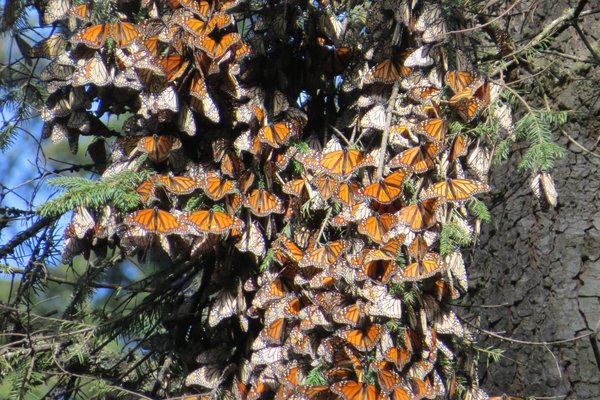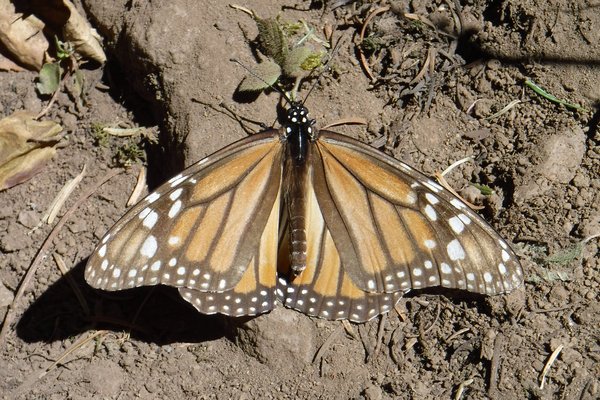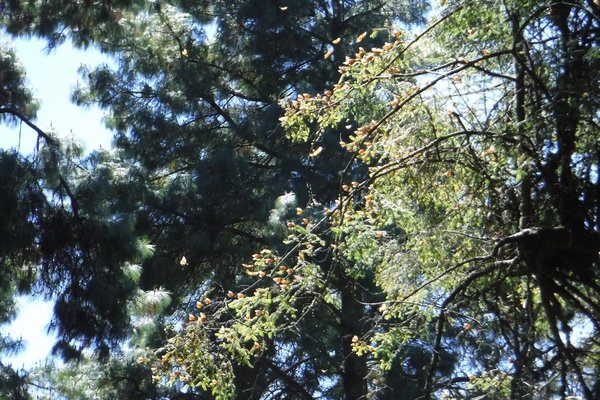Mexico
Monarch Butterfly Biosphere Reserve
The Monarch Butterfly Biosphere Reserve was created to protect the wintering habitat of the Monarch Butterfly.
The Monarch is famous for its southward migration starting in August until the first frost and northward return in summer in the Americas, which spans the life of three to four generations of the butterfly. The millions of butterflies land in close-packed clusters on the tree branches, providing a natural spectacle.
Community Perspective: This is so unique and world-class. The most visited location is El Rosario, where accompanied by a guide, you can see them waking up in the heat of the sun. Entomologist Frédéric found it was just made for him and he visited two locations in depth. Be aware that the butterflies are only present in Mexico from November to March and only start moving around when it’s not too cold.
Site Info
Official Information
- Full Name
- Monarch Butterfly Biosphere Reserve (ID: 1290)
- Country
- Mexico
- Status
-
Inscribed 2008
Site history
History of Monarch Butterfly Biosphere Reserve
- 2008: Advisory Body overruled
- By IUCN (later overruled by Committee): integrity issues
- 2008: Inscribed
- Inscribed
- Type
- Natural
- Criteria
- vii
Links
- UNESCO
- whc.unesco.org
- Official
-
- biodiversidad.gob.mx — Mariposa Monarca
- Related
-
- cbc.ca — Monarch butterflies raised in captivity may not migrate to Mexico
- en.wikipedia.org — Wikipedia entry: Monarch Butterfly Biosphere Reserve
All Links
UNESCO.org
- whc.unesco.org — whc.unesco.org/
Official Website
- biodiversidad.gob.mx — Mariposa Monarca
Related Resources
- cbc.ca — Monarch butterflies raised in captivity may not migrate to Mexico
- en.wikipedia.org — Wikipedia entry: Monarch Butterfly Biosphere Reserve
News Article
- May 25, 2022 theguardian.com — Monarch butterflies bounce back in Mexico wintering grounds
- May 31, 2021 washingtonpost.com — How the amazing monarch butterfly migrants became refugees — from us
- Feb. 2, 2020 kfgo.com — At famed Mexican butterfly reserve, second worker found dead
- Jan. 22, 2020 bbc.com — Mexico butterfly conservationist's disappearance sparks alarm
- Jan. 6, 2020 washingtonpost.com — Climate change is playing havoc with Mexico's monarch butterfly migration
- Feb. 27, 2016 theguardian.com — Monarch butterfly migration to Mexico jumps after years of decline
- April 13, 2015 enewspf.com — Groups File UNESCO Petition to Save Monarch World Heritage Site in Mexico and should be declared “in danger"
- Feb. 19, 2014 canada.com — Monarch butterfly on political agenda?
- Feb. 4, 2014 cbsnews.com — Monarch butterflies drop, migration may disappear
- March 17, 2013 cbc.ca — Monarch butterfly numbers drop by 'ominous' 59%
- March 17, 2012 washingtonpost.com — Number of Monarch butterflies wintering in Mexico drops 28 percent
Community Information
- Community Category
- Wildlife habitat: Fauna
- Natural landscape: Forest
Travel Information
Seasonal WHS
Guided Tour Only
Recent Connections
-
Guided Tour Only
At El Rosario it is obligatory to go wi… -
Affected by Climate Change
Climate change and extreme weather cond… -
On Banknotes
100 peso note in the G-series (issued 2…
Connections of Monarch Butterfly Biosphere Reserve
- Trivia
-
-
On Banknotes
100 peso note in the G-series (issued 2021) shows Temperate forest ecosystems represented by the monarch butterfly and the Monarch Butterfly Biosphere Reserve
-
- Ecology
-
-
Anteaters
northern tamandua
-
- Damaged
-
-
Affected by Climate Change
Climate change and extreme weather conditions are already affecting the World Heritage site itself, but also the butterfly habitat across the USA and Canada. Severe rain, snow and freezing temperatures caused mass mortalities of monarchs in the overwintering sites in 1981, 1992, 2002 and 2004, but particularly in March 2016. A severe storm and snowfalls in March 2016 also caused severe damage to many forest areas within the Biosphere Reserve (IUCN Outlook 2020).
-
- World Heritage Process
-
-
Inscribed on a single criterion only
vii. to contain superlative natural phenomena or areas of exceptional natural beauty and aesthetic importance
-
- WHS on Other Lists
-
-
World Heritage Forest Programme
-
Biodiversity hotspot
Mesoamerica -
World Biosphere Reserves
Mariposa Monarca (2006)
-
- Timeline
-
-
Holocene
It is thought that monarchs were originally tropical butterflies that underwent range expansion. Scientists are not sure how long the monarch's spectacular annual migration to Mexico has been occurring; it may be as old as 10,000 years (when the glaciers last retreated from North America) or as young as a few centuries
-
- Science and Technology
-
-
Recently discovered
"When Dr. Fred A. Urquhart began his studies of monarchs in 1935, one of the biggest puzzles was, where do all butterflies go? It took forty years of painstaking research to find the answer". "In 1975 when the stunning discovery of the first winter roost gave the answers" (Nom File) The first discovery by scientists tok place on Jan 2 1975
-
- Visiting conditions
-
-
Seasonal WHS
Butterflies are only present from November to March -
Guided Tour Only
At El Rosario it is obligatory to go with a local guide who can be hired from the park entrance.
-
- WHS Names
-
-
Protection of a single named species
Monarch butterfly: "The Monarch Butterfly Biosphere Reserve World Heritage property protects key overwintering sites for the monarch butterfly." (OUV)
-
News
- theguardian.com 05/25/2022
- Monarch butterflies bounce back in…
- washingtonpost.com 05/31/2021
- How the amazing monarch butterfly …
- kfgo.com 02/02/2020
- At famed Mexican butterfly reserve…
Recent Visitors
Visitors of Monarch Butterfly Biosphere Reserve
- Alberto Rodriguez Gutierrez
- Alexander Lehmann
- Alex Baranda
- Anna Wludarska
- Argo
- Aspasia
- Atila Ege
- Badwater
- brendairala
- brornt
- Carlos Sotelo
- Cheryl
- Christine
- Clyde
- Daniela Hohmann
- Delphine Delaunay
- Dimitar Krastev
- Els Slots
- Eva Kisgyorgy
- Fan Yibo
- Feldhase
- Filip Murlak
- Frédéric M
- GeorgeIng61
- headventure
- Iain Jackson
- Ian Cade
- IreneKD
- Ivan Rucek
- Jana and Matt
- Janos
- Jarek Pokrzywnicki
- Javier Coro
- Jens
- Joel on the Road
- KarenBMoore
- Kasper
- Kbooth
- Kurt Lauer
- Lara Adler
- laris.kowal
- Little Lauren Travels
- ljowers
- Lucas Del Puppo
- Ludvan
- Luis Filipe Gaspar
- Lukasz Palczewski
- Martina Rúčková
- Michael Novins
- michaelsballard
- Mihai Dascalu
- Mikko
- MoPython
- Mstrebl1990
- nan
- Nihal Ege
- Patrik
- Philipp Peterer
- puessergio
- Ralf Regele
- Roger Ourset
- Roman Bruehwiler
- scubarrie
- Sergio Arjona
- Shandos Cleaver
- sibariam
- Slavi
- Solivagant
- Stan
- Stanislaw Warwas
- Szucs Tamas
- Tim Allen
- triath
- Van Hung
- Wojciech Fedoruk
- Xiquinho Silva
- ZCTLife
- Zoë Sheng
Community Reviews
Show full reviews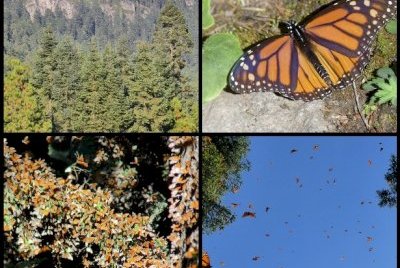
I visited this WHS just before New Year's Eve 2021 using Ocampo as my base. Already on the highway coming from Morelia there were signs to slow down due to the monarch butterfly migration. Indeed many butterflies are killed each year as roadkill just before the end of the impressive and length migration journey done by the butterflies each year. Ocampo is at an altitude of over 2000 metres so it might be a good idea to rest well before the uphill hike to the butterfly sanctuary if you suffer from altitude sickness. Horse riding tours to the sanctuary are also organised and are a pleasant way of exploring the biosphere reserve. Also, in Ocampo's central plaza, quite a long way from the El Rosario entrance proper, there is the UNESCO WHS inscription plaque.
During peak season, it seems to be normal practice for locals to organise "pacific" demonstrations which in my case meant being obliged to pay some pesos to be allowed access to the road leading up to the El Rosario entrance which was blocked with stones and a rope/chain till I paid the unofficial fee. Moreover, apparently also during peak season, the parking lot for tourists and visitors is some two hundred steps further down now from the upper parking lot used by local vendors, rangers, and the police. Apart from an additional uphill climb up the stairs (and downhill after the visit), you'll be bombarded by local vendors mostly selling the same souvenirs/stuff and repeating …
Keep reading 0 comments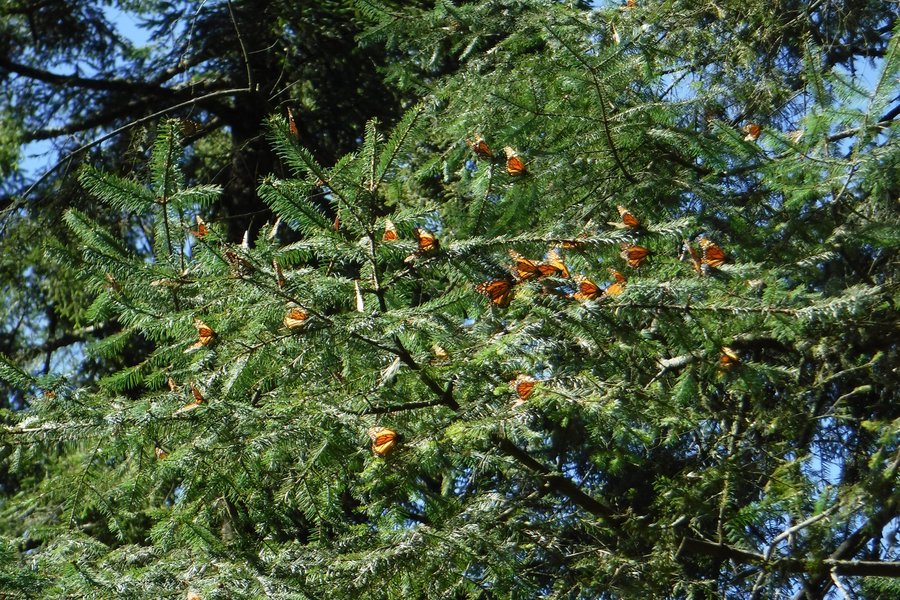
I am an entomologist, both amateurly and professionally. This means that my job is to study insects, but that I also collect insects as an amateur out of passion. In fact, the monarch is the first butterfly I got when I learned how to pin and preserve specimens. In addition, we have planted milkweed in front of the house (the monarch's host plant) and we follow the development of caterpillars and chrysalis every summer. It was therefore natural to visit them on their wintering grounds with the rest of the North American population. This WHS was definitely made for me and it was the main reason why I chose Mexico as my destination in 2019. My expectations were very high and, fortunately, I was not disappointed.
I landed in Mexico City from Montréal and took the metro to the Observatorio bus station, from where buses to Angangueo frequently leave. This small town on the border of the states of Mexico and Michoacán is the perfect base camp to visit the sanctuaries. I spent three nights there in mid-February, the first night to arrive and drop off my suitcases and the next two nights to visit two sanctuaries. It is also a convenient town to thereafter reach Morelia via Zitácuaro. Monarchs were already flying in the village when I arrived. On my first day, I met a very friendly guide and driver with whom I planned my two excursions. The price may have been too high, but I was not yet …
Keep reading 0 comments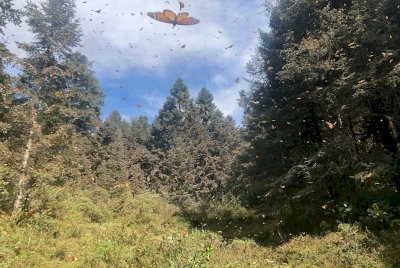
In February 2020, I made my second visit to the small cloud forest reserves, about two hours northwest of Mexico City, where each year hundreds of millions of monarch butterflies from southeastern Canada and the northeastern United States spend the period between mid-November and mid-March. I took a bus from Terminal Observatorio in Mexico City to Zitacuaro, and then a taxi to JM Butterfly B&B in nearby Macheros (both the bus and the taxi cost MXN300, around US$15). JM Butterfly B&B arranged trips to Cerro Pelon (not very crowded and just a few minutes from the hotel) and El Rosario, the largest sanctuary, about 90 minutes from the hotel, but very crowded with visitors, although the most monarchs.
Keep reading 0 comments
The Monarch Butterfly Biosphere Reserves is one of those really unique world heritage sites. As far as I can tell there is nothing on the list that compares to it: a forest full of butterflies. Simply amazing.
With my mandatory guide, I hiked into the park. At first, there were scores of dying butterflies on the ground. Then we ran into larger clouds of butterflies swirling in the air. And eventually, we made it to the butterfly covered trees.
Unfortunately, I visited before lunch. The time wasn't perfect. The parks are in the mountains and before lunch, it's cloudy and potentially too cold for the butterflies to fly around. They even put up a sign (see picture).
Getting There
The first question for getting there is not about the location: It's about the time. The monarch butterflies migrate North during summer and are only in the area during winter, roughly November to March. I came in December/January so this was not an issue. Visiting outside butterfly season does not count in my eyes.
I went on a day trip from Mexico City by bus. There are 1-2 daily connections to Angangueo. We arrived in Angangueo around 11 a.m. From there I took a cab (negotiate rate) to take me to El Rosario and back.
I had been in Morelia before and I am pretty sure you can arrive from that direction, too. But I was short on time and little information on bus …
Keep reading 0 comments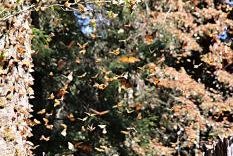
Inspired by the other reviewers I chose El Rosario to tick off this site. Google Maps does not know it, but once you are within the region it’s signposted, there are not too many roads and people are happy to point you into the right direction. I started my trip from Morelia at around 09:15, arriving on site just before 12. The roads are not great and it felt like there was a speed bump every 100 meters, but the site itself provided such a great experience that I would do it again. Do to my rather late arrival it was already quite warm and the butterflies were very active. Thousands of butterflies flew around me and made me feel like I was in a cheesy romantic movie. The area where the butterflies actually are is rather small, so the time you will spend on site is almost nothing compared to the time you need to go there and back. But still an unforgettable experience and among my favorite sites in Mexico so far.
Keep reading 0 comments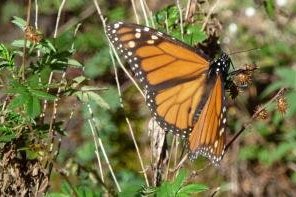
This was one of those spine tingling locations that I never would have visited if it was not for the place on the world heritage list. Even with high expectations nothing really prepared us for the astounding moment when thousands of butterflies burst into the air, a real life enhancing moment!
After a wonderful night in front of a log fire in the highly recommended Don Gabino hotel in Angangueo, we had a knock on the door with a friendly local english speaking guide offering his services for the day. Delighted we set off for Sierra Chincua sanctuary, which he said offered an easier ascent and a better viewing experience, both seemed accurate to us. He said that the best viewing experience is at Cerro Pelón, however it is a more remote cluster and is a three hour hike each way to visit it. At Sierra Chincua We actually had the whole sanctuary to ourselves, only encountering other visitors as we were departing.
The initial view of the clusters of monarchs hanging in the trees showed them in giant clumps, looking like dead leaves. As we delved deeper there were more and more of these giant clusters the sheer quantity was staggering. It was still cool and they were mostly all huddled together but there were still a lot stretching their wings and flying around. Being the only people around I was amazed that I could actually hear the butterflies flapping their wings as they fluttered around the tree tops …
Keep reading 0 comments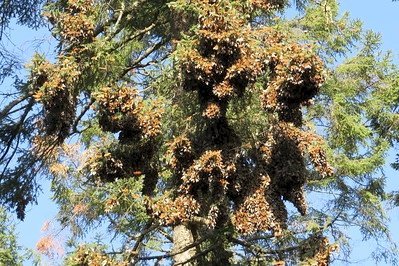
This is such a unique WHS, and my visit was all that I had hoped for. I stayed overnight in the nearest city, Zitacuaro. From there it’s an easy drive up into the mountains where the butterflies stay for the winter. The landscape around here is very un-Mexican, more Alpine or Nepalese. I had witnessed that already the day before when driving from Morelia to Zitacuaro via mountain road #15.
There are varying reports about what is the best time to see the butterflies. Considering which month, February is supposedly the best with January and early March as alternatives. The little creatures stay “in bed” (huddled together hanging from a tree branch) when it’s too cold. They will fly out for the day when they feel the sun glowing on their wings, so a sunny day is better than a clouded one. Finally, the parks are the busiest on the weekends when Mexican daytrippers are visiting. My visit as described below was on Friday, January 17, and I arrived at the butterfly viewing point at about 10.45 a.m.
I choose El Rosario for my visit, as it’s the most accessible park. Entrance to the park is now 50 pesos (about 3 EUR), for which you also get a (compulsory?) guide assigned to you. I was the third visitor of the day. We walked up the mountain slowly, stopping now and then to look for birds (many hummingbirds here) or catch our breath. It’s a steep climb on a …
Keep reading 0 comments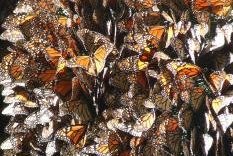
We are keeping our fingers crossed that the Monarch Butterfly forests will be inscribed this year – not just because it will add to our “visited list” but also because it is clearly such a world class natural site! What can stop it? Well, IUCN often seems more concerned with “process” than the inherent value of a site so perhaps the buffer zones haven’t been adequately defined or else the management plan isn’t thick enough!
Actually, when we were there in Mar 2008, we felt that the Mexicans were doing quite a good job at balancing the “needs” of the butterflies with those of the large crowds who had come to see them. Down below at the bus station and car park and for some of the pathway up there was a carnival atmosphere – Mariachi bands and all sorts of Mexican food goodies. One got the feeling that a spring trip to see the butterflies was a traditional “good day out” for many and indeed some of the “oldies” looked as if they may have been doing the trip annually for many years – despite the steep climb (allow up to an hour given the crowds on the path)!.
As you approach the butterfly area, the ground becomes covered with the bodies of dead insects – one of the amazing aspects of this site is the way it brings home the sheer profligacy of nature. But there is a reasonable number of wardens to rope off the path and …
Keep reading 0 comments
